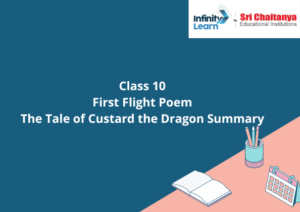Table of Contents
https://infinitylearn.com/surge/biology/biology-questions/top-100-biology-questions/Introduction to the Poem:
Ogden Nash wrote a poem about Belinda, a young girl with many pets, including a black kitten named ink, a grey mouse named blink, a yellow dog named mustard, and a coward dragon named custard. Except for the dragon, a coward, the poet has depicted every character as brave. When a pirate attacks Belinda’s house, though, everything changes. The dragon murdered the pirate since no one else dared to fight him. The characters are overjoyed because the dragon has saved them, but they immediately alter their minds and define themselves as more robust if circumstance had not been so perplexing.

About the Poet:
Frederic Ogden Nash (1902-1971), an American poet known for his light verse, died in 1971. He was well-known for his comedic poems. In 1964, he got the Sarah Josepha Hale Award.
NCERT Solutions for Class 10 English
Summary of the Poem:
The story of Custard the Dragon is told in the form of a ballad. It’s a lighthearted poem about a timid dragon named Custard. Custard is a pet of Belinda, a little girl who lives with her pets in a small white house. She had a cowardly dragon custard, a black kitten named ink, a grey mouse named blink, yellow dog mustard, and a black kitten named ink. According to the poet, they are all exceedingly brave except for the dragon. Others have been compared to animals such as bears, tigers, and lions, but the dragon is extremely fearful. He is continuously looking for a secure haven. All of the other characters mock him. However, they are astonished one night when a pirate enters the house. They are all terrified and begin to hide in various places. The dragon, however, not only tackles him but also swallows him up, much to everyone’s amazement. They thank him because the custard rescued them all. However, they eventually understand that they used to make fun of the dragon because he was shy. So they all start bragging about how brave they are and how much better they could have handled the situation. In this poem, the poet conveys the idea that in life’s most difficult moments, a shy person can be a true hero.
FAQs:
Question: In this poetry, who are the characters? Could you make a list of their pet names?
Answer:
- Belinda, a young girl.
- Ink is the name of a little black kitten.
- Blink, a little grey mouse.
- A yellow-colored dog named Mustard.
- Custard is the name of a cowardly dragon.
Question: Custard cried for a lovely, safe cage, but why? What is the origin of the name “cowardly dragon”?
Answer: Custard screams for a protective cage because he is a coward. Because other characters are classified as being highly brave in the following way, he is referred to as the coward dragon:
- Belinda has been compared to a barrel full of bears for her bravery.
- Ink and blink can pursue lions down the stairs.
- Mustard was as fearless as a raging tiger.
In the poem, the poet uses a variety of poetic devices. For example, the poetic device here is a simile: “Clashed his tail like iron in a dungeon.” Can you and your team come up with a list of other poetic devices used in the poem?
The poet has employed a variety of literary devices to enhance the poem’s beauty. He used the word ‘winda’ instead of ‘window’ to rhyme with the word ‘Belinda.’ ‘Household’ is rhyming with’ mousehole,’ and ‘wagon’ is rhyming with ‘dragon.’ Not only that, but he also employs the literary device of repetition, as evidenced by the repeated use of the word ‘small’ to describe her home and pets. The phrase “And her real, tiny pet dragon” is repeated in multiple stanzas, indicating the employment of the literary device of the refrain.
Reread verse three to see how the poet portrays the dragon’s look.
The dragon’s appearance has large sharp fangs and spikes on top. This indicates that the top of its skin is pointy. It features scales on the lower section and bony plates that protect the skin. Because the dragons are thought to be able to discharge fire from their mouths, their mouth has been compared to a fireplace. His nose is even compared to a chimney intended to expel smoke. His feet resemble a blade or a sharp knife.
Is The Tale of Custard the Dragon a serious or light-hearted poetry for you? Give reasons to back up your response?
Custard, the Dragon’s Tail, is a lighthearted poem. All of the characters’ names rhyme with one another. Except for the dragon, they are all described as courageous. In actuality, though, the dragon emerges as the true hero. When the pirate attacks them, the dragon swallows him whole. Even though none of the other characters were bold enough to confront the pirate, they nevertheless regard themselves as more powerful than the dragon after the crisis is resolved by the dragon alone. The poet, however, described the dragon as a coward from the beginning of the poem.







